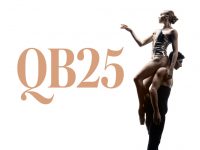As we all race ahead first into the New Year, I thought it could be an appropriate time for students of dance to pose these questions:
How can I stand out when working with a new teacher or choreographer?
What are the do’s and don’ts of attracting attention in a good way?
Well – after a few weeks of summer workshops, and with Fulltime Courses around the country gearing up for the year ahead, I have put together some answers to guide you on your way.
I asked a few teachers to answer these questions to give you an idea of what is going on in the mind and eye of the teacher or choreographer, when they set to work with a class of students, and whilst the answers are expressed very differently, you may be surprised at how similar the answers are.
On our panel for this article are:
- Adam Blanch – who is an experienced performer and teacher. With credits including the Queensland Ballet , ADT and Sydney Dance Co, Adam is now in great demand teaching and choreographing for dance schools, fulltime courses and workshops all over the country. He is currently based in Sydney.
- Lynette Denny – Lynette is of course, my very own mother and was Director of Warralong Dance Centre, which became Theatre Arts Mackay for over 45 years. She also directed The Queensland Young Dancers Company for over two decades and was President of the Queensland Ballet for nine years. A highly regarded dance professional, Lynette works as a guest teacher and choreographer and continues to adjudicate Eisteddfods and work within various arts communities in the Brisbane area.
- Christine Denny – Well – I have taught all over Australia including the junior and Fulltime programmes at Brent St and ED5, David Atkin’s Dynamite, NIDA and am now the Creator and Director of my tap dance syllabus Tapatak Oz which trains both teachers and students in tap dance. Examinations are now in full swing and I regularly work as a guest tap teacher, adjudicator, examiner and choreographer around Australia: www.tapatakoz.com.au

So here we go with the questions:
1. What makes a student stand out to you when teaching a workshop or class?
Adam: I’m always impressed by individuals who are motivated to try new things. As a teacher, when conducting a workshop you can’t expect everyone to be at the same standard, and it’s the teacher’s duty to create an atmosphere where young dancers feel free and comfortable to attempt new techniques and be allowed to fail or succeed in an environment free from judgement. I’m always excited and motivated by dancers who try their best and practice. I have no problem if a dancer is struggling with choreography or how to manage a movement, but if the same person leaves the floor and sits against the wall or starts up a conversation with a colleague and returns to make the same mistake, I become very frustrated. I have so much more respect for, and will inject more of my energy into a dancer who puts in over time to get things right and improve. There are many excellent young dancers at the moment who technically are all equally as skilled. It’s those individuals that sacrifice a little more and who do the little extras that are not expected of them that will benefit in the future.
Lynette: I have to say that the first thing I am unconsciously drawn to is the potential of the student’s physique, but as the class/workshop/audition progresses this gives way almost completely to the “intelligence” and “spirit” of the student’s approach to the work.
A student who is “listening” and “hears” the detail of the instruction, and who then responds with a willingness and obvious love for what they are doing will always capture my attention. The expression in the eyes, and particular body language have their own message.
Christine: For me it is the enthusiasm for the class and what we are doing that really makes a student stand out. The more engaged the student is with the work – the more I want to give back to them as well. Eagerness, an animated expression, the asking of questions that show some real passion, thought, understanding or willingness to improve and bring the steps to life – these are the qualities that draw me to a student. The actual experience and technical level of the tapper, or their natural ability are secondary to willingness, animation, energy and enthusiasm displayed. You can not replace showing joy for what you do, For me – this outweighs all other attributes. A genuine love of tap and rhythm will draw me to a student every time.
2. What are your “dos and don’ts ‘ for students when attending workshops?
Adam: Ask questions! Take risks and don’t be afraid to fail. Be prepared to fail and not get frustrated. Learn to listen to the information being given to you, then keep clam and learn how to practically apply the information. Take pride in the way you present yourself so you can make a good first impression but dress appropriately for the class, if your doing a contemporary workshop don’t come in wearing ballets flats, pink stockings and your hair pulled back in a bun….. that really bugs me!
Lynette: DO present yourself appropriately dressed and groomed for class.
DO stay focused throughout, and as well pay particular attention to both the teacher and the rest of the class when watching on the sidelines.
DO take in every correction and direction given, those for yourself, and those for everyone else. Maximize the information you can gain from that experience…..you may need it some day.
DO accept personal correction graciously, and be thankful that the teacher has taken the time to help YOU with YOUR particular difficulty.
DO move quickly into different parts of the studio as directed.
DO be considerate of the space other students require, especially when working on diagonals and lines. Your awareness will contribute to the smooth flow of the class, and also help to prevent accidents.
DON’T be late…make sure you are sufficiently warmed up BEFORE the starting time, and if you are late remember to apologize to both teacher and class, as you have disturbed their time.
DON’T have your mobile out…it should be turned to silent and well away.
DON’T distract the other students and break the focus of the lesson by chatting to others….even when resting or waiting your turn.
DON’T show bad attitude when given a correction. Correction is an essential part of the learning process.
DON’T come into class with gum etc. in your mouth.
Christine: I find most teachers and choreographers have their “pet hates” that they find distracting or annoying! For me it is quite simple. Do – look interested, pay attention, show energy and enthusiasm, show your personality and a joy for tap dance or whatever class you are in. Do not – walk into class late without excusing yourself, ask when will the class be over, talk over the top of the teacher, talk to others when the teacher is talking and most importantly – do not have your mobile phone turned on or anywhere where it can be seen. Finally – do not yawn with your mouth open or roll your eyes for any reason – take corrections as the compliment which they are – in that, the teacher has taken the time to give you individual feedback on what you are doing…..they have shown interest in you. Look interested even if you are not, otherwise – leave the class to be enjoyed 100% by the others who are interested. And if you need to yawn – cover your mouth with your hand.
3. How do you think students can best work with new teachers and their choreography to capture what they are looking for and trying to achieve?
Adam: Once again I feel its just being open to new styles, methods, pathways etc. Try to break habits during the workshop and apply techniques you are being shown. Usually a workshop only lasts a day or week and once you leave you have the choice then to apply into your regular practice. Basically take it on board for the time your there, you paid to learn new skills then feel free to take it or leave it when your done.
Lynette: Enter the room with an “open mind”, and a cheerful disposition. There are many different styles and techniques in the world of dance. Embracing something new does not necessarily negate prior learning or concepts.
Try to find the “broad picture” of the style and intent first, then worry about the tiny details as you progress through the class. A helpful hint after you have established a broad picture is to find the Rhythm and Direction (or Floor Pattern) of the piece, regardless of genre, and this will also be a help to send you on your way to eventually achieving the choreography.
Try to respond quickly to directions with a pleasant attitude and good energy.
If you don’t understand a direction,save everyone’s time by asking for help sooner rather than later.
Christine: In tap I think it is especially important for students to realize that just like jazz and other dance genres, there are different styles of tap. Quite often, students come in with a very closed mind as to “what tap is” and have a difficult time moving in other directions. Also remember that unlike ballet, where terminology is quite uniform globally – tap is not like this. The same step can be called a number of things, depending on where you are in the world, or whether or not you studied syllabus or open classes. Eg: Heels = paddles = rolls = heel up step heel = parradiddles etc All are valid! So – look at the step, hear the step, recognize it and accept that maybe your teacher today calls it something different to the teacher you had yesterday. Also – it is important to take the base technique you have, but then listen carefully to the direction and demonstration given to capture the sound quality and visual look required by your particular teacher. For me – light and shade, the use of accent and dynamics are really important to the quality of the sound and then visually – a nice easy relaxed style that matches the music chosen. But this is just my nuanced style – another tap choreographer may want it a totally different way – and that’s cool! That’s tap! It is a fluid, creative, unique dance space!
4. What types of students inspire you and bring out your best in class?
Adam: I’m inspired and motivated by hard work. I like young dancers who are thick skinned and who know how to handle constructive criticism. So often young dancers expect to be told they’re amazing and need to hear this before they choose to push themselves.
Lynette: My favorites are students who have an “eager energy”, and a willingness to try. They are not always the most physically gifted.
I love it when a student is so focused and attentive you know that they understand “why” you are setting what you set, and sometimes they will even anticipate the next move.
Students who give their best energy and spirit, who are bright eyed, who look like they really want to be in that moment, and who engage sincerely and intelligently with you, are an absolute joy to teach.
I have been very blessed during many years of teaching and choreographing to have had the pleasure of working with many such students.
Christine: For me this is easy. The students with a passion for tap and rhythm inspire me and bring out the best. Students with a sense of humour and a “can do” attitude! So try not to hide your proverbial light under a bushel. Be energetic, keen and passionate – and show the teacher that you love what you do – and if you happen to be talented – have some energy and personality in class so they can see that experience shining through. Energy, individuality and personality, with a great natural passion and rhythm – that inspires me, and my work every time! A good piece of choreography is always, for me, the result of an enthusiastic set of tappers, with oodles of commitment, passion and joy!
So – there you have it!
Across the generations and across different genres – these are some great tips for making the most out of classes and choreography with new teachers and colleagues. And with that – I wish you all a happy, passionate and fulfilling year of dance,
Christine
www.tapatakoz.com.au
info@tapatakoz.com.au













